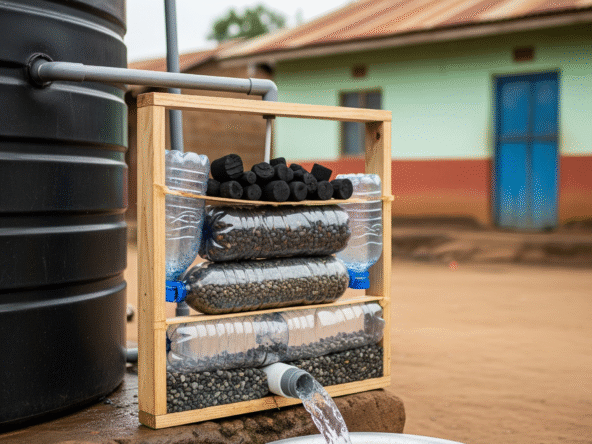As climate patterns shift and Kenya faces more frequent dry spells, rainwater harvesting has become essential—not just for rural households, but for peri-urban homes, schools, and farms as well. However, collecting rainwater directly into your main storage tank without a filtration buffer introduces a major problem: contaminants.
Pre-filtration tanks serve as a vital first layer in any rainwater harvesting system. These small, often overlooked components ensure that your main storage tank receives cleaner, sediment-free water, which helps avoid clogs, algae growth, and frequent cleaning cycles.
Whether you use plastic water tanks on raised stands or have a gravity-fed underground system, a properly installed pre-filtration tank can prolong the life of your storage, pipes, and pumps.
1. What Is a Pre-Filtration Tank?
A pre-filtration tank is a medium or small-capacity container usually between 50 to 250 litres connected between the gutter downpipe and your main water tank. It serves several purposes:
- Settling chamber for silt, dust, and roofing debris
- Filter catchment for organic waste like leaves and insects
- First-flush diverter to release dirty water from the start of a rainfall
- Flow regulator that ensures cleaner water reaches the main tank
For households that regularly clean tanks (see How to Clean and Maintain Household Tanks), the addition of a pre-filtration unit can reduce cleaning needs to just once or twice a year.
2. Types of Pre-Filtration Tank Designs
Kenyan homeowners can choose from a variety of pre-filtration setups depending on their budget, available space, and roofing conditions. Common systems include:
| Design Type | Description | Best Use Case |
|---|---|---|
| First-Flush Diverters | A vertical pipe stores the first 10–20 litres of rainfall and automatically drains it out before water flows into the storage tank. | Homes near roads, dusty roofs, urban estates |
| Inline Basket Filters | Mesh-lined baskets fitted in the flow path trap leaves, plastic, and larger waste. Easy to remove and clean. | Homes with tree cover or older roofing sheets |
| Mini Settling Tanks | Small tanks that slow down incoming water, allowing debris to settle at the bottom. Water exits from the middle or upper level. | Sloped terrain, rain-heavy zones |
| IBC Pre-Filters | Modified IBC tanks with mesh inlets | DIY setups, off-grid farms, temporary systems |
A key consideration is how much roof surface you have and how quickly water will flow into the system during heavy rain.
3. Why Install a Pre-Filtration Tank?
Even a small 100-square-metre roof can deliver over 1,000 litres of water during a short rainfall. Without filtration, this volume brings contaminants that quickly affect:
- Water color and smell
- Pump performance, especially in pump-based systems
- Tank lifespan due to internal grime buildup
- Effectiveness of greywater systems, especially those combining overflow reuse setups
Additionally, cleaner water going into your main tank reduces sediment clogs in overflow pipes, filters, and pump nozzles common pain points for homeowners using automated refill systems.
4. Ideal Placement and Setup Instructions
Proper installation of your pre-filtration tank is as important as choosing the right design. Follow these placement tips:
- Position the tank directly below the main downpipe from your gutters.
- Add a removable debris screen or mesh at the entry point.
- Connect the outlet of the pre-tank to the main tank’s inlet with a sealed PVC pipe.
- Include a first-flush pipe that diverts the first 10–15 litres of rain (which typically carries dust and roof grime).
- Ensure the tank base has gravel or splash stones to prevent erosion.
If your compound already features well-planned overflow piping, the pre-filtration tank can be connected to drain into those systems when it exceeds capacity.
5. Materials, Cost, and Assembly
The great advantage of pre-filtration tanks is cost flexibility. You can purchase ready-made units or build your own using:
- 100–250L plastic drums with mesh lids
- Modified stackable tanks or buckets
- Cut IBC containers fitted with valves and filters
- Raised DIY tank stands to use gravity for flow
Typical material cost breakdown:
| Item | Price Range (KSh) |
|---|---|
| 100L plastic drum | 1,200 – 2,000 |
| Mesh filter or stainless tray | 200 – 400 |
| Overflow and outlet fittings | 300 – 800 |
| First-flush PVC pipe setup | 500 – 900 |
For a basic DIY unit, KSh 2,000–4,000 is sufficient for most home installations.
6. Monthly Maintenance Checklist
While pre-filtration tanks require less cleaning than main tanks, they still need monthly inspection:
- Remove debris and clean filters or mesh baskets.
- Drain any settled sludge from the bottom of the tank.
- Check for blockages in the first-flush diverter.
- Confirm that overflow pipes are free and draining properly.
- Tighten any loose clamps, fittings, or pipe joints.
This quick check (usually under 15 minutes) can extend the life of your entire water system and reduce the risk of blockages or contamination.
A rainwater pre-filtration tank isn’t a luxury it’s a core component of any long-term rainwater harvesting system in Kenya. It helps prevent downstream problems, keeps your water clean, and ensures that tank cleaning, pump repair, and overflow damage are minimized.
With options ranging from IBC conversions to first-flush diverters, every Kenyan household whether in Nairobi, Kisumu, or Eldoret can afford to install a functional pre-filtration unit. When combined with off-grid planning and water-efficient fittings, these small upgrades make a big difference.
Explore More on the Blog:


